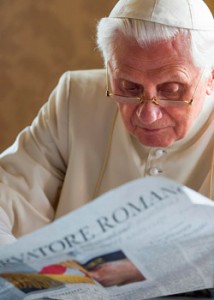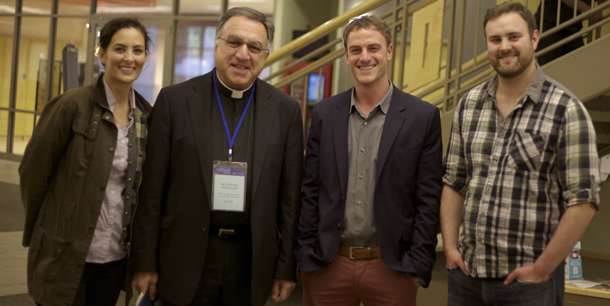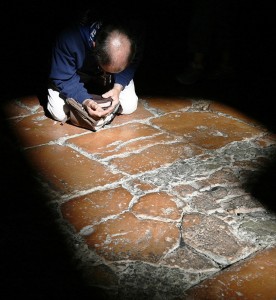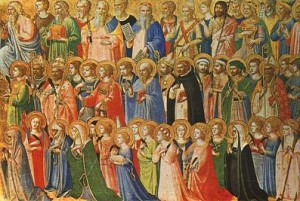 The CEO of Canada’s Salt + Light Catholic Media, Fr. Rosica’s address at De Paul University, Chicago during World Catholicism Week 2012 was entitled Making TIme for God.
The CEO of Canada’s Salt + Light Catholic Media, Fr. Rosica’s address at De Paul University, Chicago during World Catholicism Week 2012 was entitled Making TIme for God.
” Look to the lives of the saints and blesseds who made room for God, who loved Christ and imitated him, and who allowed us to glimpse moments of heaven on earth. The saints and blesseds are the Facebook of the Church. They are the antidotes to a culture that tells us that another person’s presence is not necessary. There is nothing virtual about the lives of the saints and blesseds. In the midst of conflict, hostility, suffering and martyrdom, they remained present to the people around them. During times and crises of immense fragmentation and division, they kept their feet firmly planted on earth and their eyes fixed on their heavenly homeland. They model for us authentically human relationships that begin on earth and lead us into heaven. They teach us how to make room for God in our lives.”
Fr. Rosica was appointed by Pope Benedict as Consultor to the Pontifical Council for Social Communications. As of December 1, 2011, Fr. Rosica is also President of Assumption University in Windsor, Ontario (Canada.)
His talk in outline..
- Is there a time and place for God in Social Networking?
- Why Jesus is still attractive today
- Jesus taught us about the Father
- Silence and the Word
- Looking at the Church through biblical lenses
- Moving Beyond Ideology
- Hope: a manifestation of the Spirit
- Three people who found time for God
- Blessed Marianne Cope, Mother of the Outcasts
- Blessed Kateri Tekakwitha: Enduring Model of the New Evangelization
- Blessed Pedro Calúngsod: the Good Soldier of Christ
- Conclusion: the Facebook of the Church
Dear Friends,
I am very grateful for the opportunity to address you during DePaul University’s “World Catholicism Week.” It is a real pleasure to finally visit America’s largest Catholic university! I have given much thought to the topic of “Making Time for God.” The necessity of having time for God – time to step back and slow down for spiritual reflection – is becoming more complex and more necessary than ever before. Our current fast-paced, plugged-in information age, which leads us to believe that we can do many things simultaneously, quickly and efficiently without critical reflection, contemplation and the requisite silence is beginning to wear on us. We are rushing everywhere, with wires in our ears, decked out with bluetooth apparatus, laden with smart phones, iPads, and soon-to-be outmoded laptops. Every day we ask ourselves, “Do I have time to attend this meeting, go to that volunteer activity, finish this paper, eat dinner, etc.?” “When is the last time I had a significant, one-on-one, face-to-face conversation with another human being?” “When have I sent a paper greeting card or written a letter to a friend with a good old pen and paper?” “How, when and where will I ever find time for God?”
Tonight I would like to look at how we make room for God, for Jesus and the Church in our lives in the midst of our information age. I will also consider some of the core elements of Catholic spirituality that are essential to our being authentic Catholic Christians in a world undergoing massive change. Over the past weeks we have read and heard much about what causes people to leave the Church. Solid, valid points have been raised by some credible, scientific polls. But I would like to ask you tonight: What attracts us to Christ and the Church? What keeps us alive in the Church? What are the challenges before us that can detract us from Christ and his saving mission? How can we communicate with God and about God in the midst of endless noise and competing distractions? How can we understand the Church today with all of her ambiguities, struggles and sinfulness? I will conclude by offering you three contemporary role models who answered these fundamental questions, made room for God in their lives and lived completely for others. They allow us to experience a bit of heaven on earth.
Is there a time and place for God in Social Networking?
 Social networking isn’t new to the Christian community. Its foundational handbook is the Acts of the Apostles and the letters of St. Paul, the media mogul and master networker of the New Testament. But the social media tools that we use for networking today are new, and those tools are changing the Christian community and the ways that we deal with one another and with God. The new tools are generating new patterns of behavior that affect not just Christian practice, but also our patterns of belief. One of the problems and challenges of Social Networking is that we no longer need to be in one another’s presence in order to enjoy the other’s company. We must ask some fundamental questions that Pope Benedict himself raised in his 2011 Message for the World Day of Communcations:
Social networking isn’t new to the Christian community. Its foundational handbook is the Acts of the Apostles and the letters of St. Paul, the media mogul and master networker of the New Testament. But the social media tools that we use for networking today are new, and those tools are changing the Christian community and the ways that we deal with one another and with God. The new tools are generating new patterns of behavior that affect not just Christian practice, but also our patterns of belief. One of the problems and challenges of Social Networking is that we no longer need to be in one another’s presence in order to enjoy the other’s company. We must ask some fundamental questions that Pope Benedict himself raised in his 2011 Message for the World Day of Communcations:
“Who is my “neighbour” in this new world? Does the danger exist that we may be less present to those whom we encounter in our everyday life? Is there a risk of being more distracted because our attention is fragmented and absorbed in a world “other” than the one in which we live? Do we have time to reflect critically on our choices and to foster human relationships which are truly deep and lasting? It is important always to remember that virtual contact cannot and must not take the place of direct human contact with people at every level of our lives.”
Why Jesus is still attractive today
 First let us consider Jesus of Nazareth, the historical Jesus – the perfect communicator and chief Social Networker – the model for all who seek to communicate the Good News today. He embodies in himself love of God and love of neighbour. During his lifetime, he attracted townspeople and country people, poor and rich, fishermen and tax collectors, women like Mary of Magdalene and her companions who provided for him and so many others out of their own means. Jesus had the ability to wow simple and sophisticated souls alike. I am sure he did it with his powerful words, but also with a gentle smile, with humor, kindness and just plain love. When Jesus spoke about the hypocrites’ gloomy looks in Matthew’s Gospel, he was also saying something about himself. He looked upon people with love and compassion and did not allow anything to distract him from the person in front of him. Jesus never “did” people or worked the crowds like a politician. He paid careful attention to each and every human being who stood before him, ate with him or knelt at his feet to seek healing and pardon.
First let us consider Jesus of Nazareth, the historical Jesus – the perfect communicator and chief Social Networker – the model for all who seek to communicate the Good News today. He embodies in himself love of God and love of neighbour. During his lifetime, he attracted townspeople and country people, poor and rich, fishermen and tax collectors, women like Mary of Magdalene and her companions who provided for him and so many others out of their own means. Jesus had the ability to wow simple and sophisticated souls alike. I am sure he did it with his powerful words, but also with a gentle smile, with humor, kindness and just plain love. When Jesus spoke about the hypocrites’ gloomy looks in Matthew’s Gospel, he was also saying something about himself. He looked upon people with love and compassion and did not allow anything to distract him from the person in front of him. Jesus never “did” people or worked the crowds like a politician. He paid careful attention to each and every human being who stood before him, ate with him or knelt at his feet to seek healing and pardon.
We can learn much from Jesus’ style of being present to others and communicating with them; from his use of parables and stories, from his attentiveness to the different audiences with which he engaged; from his personal involvement with each individual he encounters; but in the final analysis these different elements point us to the essence of Jesus as one who gives his life, who spends himself gladly for others. The highpoint of Jesus’ self-communication is in the Eucharist.
Jesus taught us about the Father
One of the most important things that Jesus taught us was about a loving Father in heaven… his Father and our Father. In the New Roman Missal, there is now only one invitation to the Lord’s prayer: “At the Saviour’s command and formed by divine teaching, we dare to say”. This is a literal translation from the original Latin text that was not translated in the previous English editions of the Missal. At the time of Jesus, no one would have dared to address God so personally and intimately as my “Father” but Jesus taught us that God is indeed our heavenly Father and so He revolutionized the way we relate to Him. The New Roman Missal emphasizes God’s great power, majesty and goodness and with this particular invitation to pray the words Jesus, Himself taught us, we are reminded that it is only because Jesus commanded us to pray using the words of the “Our Father” that we dare to so intimately address God as Father. If we do not understand the “Our Father,” then we miss out on the core of Jesus’ relationship with God, and our belonging to God and Jesus as sons and daughters, brothers and sisters in a unique family.
Let us reflect on the “Our Father.” Throughout Luke’s Gospel in particular, Jesus at prayer is a model for us. In Chapter 11, Luke offers us three episodes concerned with prayer (11:1-13). The first (1-4) recounts Jesus teaching his disciples the Christian communal prayer, the “Our Father.” They watch Him from afar, and are keenly aware of the intensity and intimacy of his prayer with God. Jesus responds to the disciples by teaching them the Our Father. The “Our Father” is taught to the Twelve in their role as disciples, not just as individuals to be converted but also as persons already co-responsible for the community.
When we pray “thy kingdom come,” we reveal our deepest longing to see the day when the triumphant, sovereign lordship of our loving God will no longer be a mere hope clung to desperately by faith, but a manifest reality in all human affairs. Our souls can never be entirely content until God’s honor is fully vindicated in all creation. When we beg for bread, we are really pleading for more than food. We beg the author of life for all the necessities of life. “God, give us what we need in order to enjoy the gift of life … bread for today and bread for tomorrow, to sustain us as a community.”
We ask God to forgive our sins as we forgive everyone their debts to us. This may possibly reflect Luke’s concern that possessions not hinder community fellowship. The final petition is most likely eschatological: Do not lead us into trial; i.e., the final, great and ultimate test and agony of evil before the end.
Jesus taught us that we must pray unceasingly, for prayer is a sign of our faith in God. Prayer is not something that we use to put pressure on God to get our own way. Prayer becomes one of the ways by which we follow Jesus in the Christian life.
Silence and the Word
 Each year for the past 46 years, popes have issued a message for the World Communications Day which is commemorated in these parts of the world on the Feast of the Ascension of our Lord. In recent years, the messages have focused on the revolution in communications caused by the Internet and have included references to blog, websites, social media, smartphones and more. For this year’s World Day of Communications, the Vatican released the Holy Father’s 2012 message that is entitled “Silence and Word: Path of Evangelization”.
Each year for the past 46 years, popes have issued a message for the World Communications Day which is commemorated in these parts of the world on the Feast of the Ascension of our Lord. In recent years, the messages have focused on the revolution in communications caused by the Internet and have included references to blog, websites, social media, smartphones and more. For this year’s World Day of Communications, the Vatican released the Holy Father’s 2012 message that is entitled “Silence and Word: Path of Evangelization”.
You can imagine some of our more vocal critics taking us to task for this year’s theme! I am part of the Pontifical Council for Social Communications at the Vatican and as soon as this year’s message was released, several people called or wrote saying: “So, you advised the Pope to tell us all to be quiet!” Quite the contrary, it was the Holy Father himself who felt that after several years of messages announcing that the Church really got it and was on board with the new media, it was time to stop, pause and reflect on what this daring, new adventure is all about.
In his message for 2012, Pope Benedict writes about the importance of silence in communication, especially listening and contemplation. Silence is an integral element of communication; in its absence, words rich in content cannot exist. The Pope tells us that we need to carve out space for silence, to create an “ecosystem” that balances the hubbub of daily life, especially with social networks and the like, and silence. Stepping away from cacophony of Facebook and Twitter and the vast wealth of information found on Wikipedia or websites helps us to exercise discernment in sifting through them, assessing them for reliability, charity, and adherence to truth and first principles. Silence and contemplation help us to wait for and discern the right answer, instead of the quick answer. God speaks to us in the silence and in silent contemplation we are immersed in the love of God. The Word is found in the silence. Out of that silent contemplation springs the mission that inspires and compels us forward in mission.
Looking at the Church through biblical lenses
There are many today who say that we can be Catholic, love God, claim Jesus as our Savior but not belong to the Church. Yet Jesus reveals himself to us through the Sacraments of Church. We must never marginalize Christian revelation and its ecclesial transmission by proposing alternatives where misuse of the terminology of “spirituality” or “Kingdom or Reign of God” is a substitute for Jesus Christ and his Church! How are we to understand the reality and mystery of the Church? Is the Church an institution like any other organization or human institution?
 In my work at Salt and Light Television Network in Canada, I have had to quickly learn about broadcast technology, and all that goes into making a good film. One important aspect of television is the intricate camera work “behind the scenes.” The close up and wide-angle camera shots make all the difference in filming and telling a story. In producing our programs or documentaries at Salt and Light, if we use too many close-ups, we lose sight of the bigger picture. If we overuse wide-angle shots without attention to the particulars, it doesn’t make for good television. Good television combines the wide-angle or panoramic shots, the intermediate views of the surface, and finally the close-ups that offer attention to detail and often provide necessary depth for understanding the whole picture.
In my work at Salt and Light Television Network in Canada, I have had to quickly learn about broadcast technology, and all that goes into making a good film. One important aspect of television is the intricate camera work “behind the scenes.” The close up and wide-angle camera shots make all the difference in filming and telling a story. In producing our programs or documentaries at Salt and Light, if we use too many close-ups, we lose sight of the bigger picture. If we overuse wide-angle shots without attention to the particulars, it doesn’t make for good television. Good television combines the wide-angle or panoramic shots, the intermediate views of the surface, and finally the close-ups that offer attention to detail and often provide necessary depth for understanding the whole picture.
At the first Pentecost, Christians received the Holy Spirit — the universal principle of Christianity — and their eyes were opened to the universal import of the Christian truth as they encountered non-Jews who received the Holy Spirit just as they had done. The whole of the New Testament can be understood as the emergence of the “catholic,” the universal, in Christian life. If Christianity had not moved from where it was particular and small, it would have been a small modification of the Jewish experience, a subset of Jewish piety that was still focused in and around Jerusalem and the restoration of a literal kingdom of Israel. The first two generations of Christians discovered that Christianity couldn’t be just that. We owe much to Fr. Donald Senior, CP of Catholic Theological Union of this great city, for his rich reflections on this very theme.
I would like to offer you three lenses through which we might consider this mystery and meaning of Pentecost, the birth of the Church:
- the wide-angle lens that looks at our belonging to the Church;
- an intermediate lens that focuses in on the ideologies at work in the Church today, and
- a zoom lens to sharpen our hope, the great manifestation of the Holy Spirit to the Church.
Pentecost is considered to be the birth of the Church. We are part of this Church and we live, move and have our being within the Church. One of the main themes permeating the thought of St. Ignatius of Loyola is his exhortation “Sentire cum ecclesia” or “think with the Church.” “Sentire cum ecclesia” also means to feel with the Church and to love the Church. It is necessary to cultivate this communion of shared devotion, affection and purpose in a very disciplined way, for not all aspects of the Church are lovable, just as we are not always lovable as individuals.
Many times during the tedious preparations for World Youth Day 2002 ten years ago, and over the past nine years of establishing Canada’s National Catholic Television Network in such complex times for the Church, I found consolation in the words of Erasmus of Rotterdam: “I accept and love the Church as it is, with all its qualities and defects, because the Church accepts me and loves me as I am, with all my qualities and all my defects.” The structures of the Church cannot exist without human mediation, with all its gifts and defects of the persons present in the Church. We cannot honor and serve the head (Christ) while disregarding or despising the body (the Church). Long ago St. Cyprian said: “Who has not the Church for mother can no longer have God for father.” Or in the words of Fr. Henri de Lubac, S.J., referring to Jesus and His bride, the Church, “What would I ever know of Him without her?”
The story of that first Pentecost in the early Church invites us once again to walk with the Church, breathe with the Church, hope with the Church, feel with the Church, “sentire cum ecclesia.” What does the Church mean for me as an individual and for us as the Catholic community? What is my personal relationship with the Church? Do I love the Church? How do we love and speak about the Church? Do we feel loved by the Church?
Moving Beyond Ideology
From the wide-angle view of the Church, let us take a closer look at our current ecclesial reality. Today, some of us seem to be stuck in the ideological battles that followed the Second Vatican Council. Perhaps we are frozen in categories of left and right; traditional vs. avant-garde; male vs. female; hierarchical vs. lay-led, or prophetic vs. static. Excessive tensions arising from Church politics, gender issues, liturgical practices, language, confusion over the “spirit of Vatican II” and not necessarily the message of the Second Vatican Council – all of these influence today’s candidates for religious life, ordained and lay ministries in the Church.
When we sell ourselves to cynicism and despair, meanness of heart, smallness of spirit and harshness in ecclesial discourse, we betray our deepest identity as bearers of joy, hope and truth. The manifestations of the Spirit must be accompanied by positive energy- because they are liberating. They ultimately set people free, and do not lead them into depression, sadness, cynicism, indifference or anger. What ideologies have dominated my life? How do I minister and function beyond ideology? What have been the dominant ecclesial ideologies at work among our various tribes? Is joy present in our communal and individual witness? What prevents me as an individual and us as a community from giving a robust, joyful witness to Jesus Christ, the Catholic Faith and the Church?

Hope: a manifestation of the Spirit
Now let us zoom in on hope, a true manifestation of the Spirit at Pentecost. Is it not true that many of us in the Church and in our parish communities today feel like we are caught in a flash flood that is unexpected, powerful, destructive and filled with despair? The media exerts a powerful influence on the thinking, the attitudes and the faith of people. The flash flood bears down with immense force on all of us. Some view our present situation with great pessimism and grow disheartened, depressed, and even cynical. Others don’t want to admit what is happening and go whistling in the dark, clinging to the illusion that things definitively past can be recovered and the claims and facts of the present ignored. For the world of sound bites, hope usually means that we make ourselves believe that everything is going to turn out all right. We use the word hope lightly and cheaply. This is not the hope of Christians. We must be icons of hope, a people with a new vision, a people that learn to see the world through the lenses of Christ, the Spirit, and the Church.
The Second Vatican Council encouraged Christians to read the signs of the times, and for Pope John XXIII these were signs of hope and glimpses of the Kingdom’s presence in our midst. It is not a kingdom of this world, so that it cannot be identified specifically in this or that location, but it is nevertheless here already, fostered by the Eucharist which is the pattern to be reproduced in all society, as well as still to come. The Kingdom manifests itself through the gifts of the Holy Spirit: wisdom, understanding, counsel, courage, knowledge, piety, and fear of the Lord. And the Spirit’s fruits make the Kingdom palpable and palatable: love, joy, peace, patience, kindness, goodness, long suffering, mildness, faith, modesty, continence, and chastity.
It is also possible to follow a via negativa and to say where the Kingdom is not. Where there is no justice, no peace, no sharing, no mutual trust, no forgiveness, there is no Kingdom. Where there is rancor, envy, distrust, hatred, ignorance, indifference, unchastity, cynicism, there is no Kingdom and certainly no life.
Make no small plans
The tongues of fire of the Holy Spirit invite us to rediscover the depth, beauty and vastness of the Church’s mission. This is not a time for hesitation or retreat. We need to keep the arena large. We must shape our vision on the firm conviction in the victory of the Cross and in Jesus Christ’s triumph over sin and death. How could I stand here in downtown Chicago tonight without evoking the famous advice of architect Daniel Burnham to the city planners of this great metropolis over a century ago: “Make no small plans. They have no magic to stir men’s blood.” Small plans do not attract young people today. They don’t attract anyone for that matter!
If we profess to be truly Catholic, we must ponder anew the whole reality of the Church, from the wide-angle view of its vastness and beauty, to the sometimes turbulent and complex surface, zooming in finally on hope, one of the deepest manifestations of the Spirit alive in the Church. In doing so, we can marvel once again at the mercy and generosity of God. Despite everything, we are still here 2000 years later!
Three people who found time for God

Several years ago Cardinal Joseph Ratzinger told an interviewer, “The only really effective case for Christianity comes down to two arguments, namely, the saints the church has produced and the art which has grown in her womb.” Catholics have the blessed privilege of seeking the beauty of holiness and the holiness of beauty. I have always found the lives of the saints and blesseds to be a great consolation and source of hope, no matter how difficult are the times in which we are living. The saints and blesseds offer us a recipe for holiness and model for us lives patterned on the Beatitudes [Matthew 5:1-12]. Each of us is called to become God’s friend. We grow in friendship with God as we do with others: by being present to God, talking with God, and being generous with God.
Many think that sainthood is a privilege reserved only for the chosen few. Actually, to become a saint is the task of every Christian, and what’s more, we could even say it’s the task of everyone! How many times have we thought that the Saints are merely “eccentrics” that the Church exalts for our imitation; people who were so unrepresentative of and out of touch with the human scene? It is certainly true of all those men and women who were “eccentric” in its literal sense: they deviated from the centre, from usual practice, the ordinary ways of doing things, the established methods. Another way of looking at the saints is that they stood at the “radical centre.”
We need the example of these holy women and men who had no moderation but only exuberance! They were people with ordinary affections, who took God seriously and were therefore free to act with exuberance. Not measured or moderate, the Saint’s response to God’s extravagant love is equally immoderate, marked by fidelity and total commitment. G. K. Chesterton said: “[such] people have exaggerated what the world and the Church have forgotten”.
Let me share with you the lives of three people who made a big place for God in their lives. Two of them speak especially to our cultures in North America: Blessed Kateri Tekakwitha and Blessed Mother Marianne Cope. They are striking examples of sanctity and heroic charity, and represent the historic role played by women in the building up of the Church on our continent. The third individual, Blessed Pedro Calungsod of the Philippines, is a stirring example of how young people can give eloquent, unambiguous witness to Christ and the Gospel with their very lives. Blesseds Kateri and Pedro were two of the patrons given to us by Pope John Paul II for our World Youth Day 2002 in Toronto. This October 21, on World Mission Sunday, the three will be canonized by Pope Benedict XVI.
Blessed Marianne Cope, Mother of the Outcasts
 Blessed Sister Marianne Cope (1838–1918), was a mother to Molokai lepers. She made room for God in her life in an extraordinary way. Sister Marianne, formerly Barbara Koob (now officially Cope) was born January 23, 1838 and baptized the following day in what is now Hessen, West Germany. Sister Marianne worked as a teacher and hospital administrator in New York. In the 1880s, as superior of her congregation of the Sisters of St. Francis in Syracuse, NY, Mother Marianne responded to the invitation to assist with the care of lepers on the island of Molokai, Hawaii. In the late 19th and early 20th century, about 10% of the Hansenites (people with leprosy) on Molokai and the Peninsula of Kalaupapa were Buddhists. Many practiced the native, indigenous religions of the Polynesian Islands. Some were Protestant and some were Catholic. She loved all whom she served and showed her selfless compassion to those suffering from Hansen’s disease.
Blessed Sister Marianne Cope (1838–1918), was a mother to Molokai lepers. She made room for God in her life in an extraordinary way. Sister Marianne, formerly Barbara Koob (now officially Cope) was born January 23, 1838 and baptized the following day in what is now Hessen, West Germany. Sister Marianne worked as a teacher and hospital administrator in New York. In the 1880s, as superior of her congregation of the Sisters of St. Francis in Syracuse, NY, Mother Marianne responded to the invitation to assist with the care of lepers on the island of Molokai, Hawaii. In the late 19th and early 20th century, about 10% of the Hansenites (people with leprosy) on Molokai and the Peninsula of Kalaupapa were Buddhists. Many practiced the native, indigenous religions of the Polynesian Islands. Some were Protestant and some were Catholic. She loved all whom she served and showed her selfless compassion to those suffering from Hansen’s disease.
Mother Marianne spent the last 30 years of her life ministering on the Hawaiian island of Molokai, working closely with Father Damien and with the outcasts of society as they were abandoned on the shores of the island, never to return to their families. When Mother Marianne died at the age of 80 in 1918, a Honolulu newspaper wrote: “Seldom has the opportunity come to a woman to devote every hour of 30 years to the mothering of people isolated by law from the rest of the world. She risked her own life all that time, faced everything with unflinching courage, and was known for her gentle smile. People of all religions of the islands still honour and revere Father Damien, now St. Damien, and Mother Marianne who brought healing to body and soul. She was beatified at the Vatican on May 14, 2005, one month after the death of Pope John Paul II. With her canonization by Pope Benedict on October 21, her life is held up before the world as a true model of holiness and friend of God, one who listened to God, made room for him in her life, and thus welcomed the world into her heart.
Blessed Kateri Tekakwitha: Enduring Model of the New Evangelization
 A second person who carved out precious time for God in the midst of much physical suffering, hostility and persecution is Blessed Kateri Tekakwitha, known as the “Lily of the Mohawks.” She was born to a Christian Algonquin mother and a Mohawk father in 1656 in upstate New York along the Mohawk River. At the age of four, smallpox attacked Tekakwitha’s village, taking the lives of her parents and baby brother, and leaving Tekakwitha an orphan. Smallpox had marked her face and seriously impaired her eyesight. Although terribly weakened, scarred, and partially blind, Tekakwitha survived. She was adopted by her two aunts and her uncle, also a Mohawk chief. The family abandoned their village and built a new settlement, called Caughnawaga, some five miles away on the north bank of the Mohawk River, which today is in Fonda, New York. Kateri was baptized by a Jesuit missionary in 1676 when she was 20, and she died in Canada four years later. The newly baptized young woman became intensely devout, and would deliberately expose herself to the pain of cold and the burn of hot coals, and pierce her skin with thorns to imitate the suffering of Jesus.
A second person who carved out precious time for God in the midst of much physical suffering, hostility and persecution is Blessed Kateri Tekakwitha, known as the “Lily of the Mohawks.” She was born to a Christian Algonquin mother and a Mohawk father in 1656 in upstate New York along the Mohawk River. At the age of four, smallpox attacked Tekakwitha’s village, taking the lives of her parents and baby brother, and leaving Tekakwitha an orphan. Smallpox had marked her face and seriously impaired her eyesight. Although terribly weakened, scarred, and partially blind, Tekakwitha survived. She was adopted by her two aunts and her uncle, also a Mohawk chief. The family abandoned their village and built a new settlement, called Caughnawaga, some five miles away on the north bank of the Mohawk River, which today is in Fonda, New York. Kateri was baptized by a Jesuit missionary in 1676 when she was 20, and she died in Canada four years later. The newly baptized young woman became intensely devout, and would deliberately expose herself to the pain of cold and the burn of hot coals, and pierce her skin with thorns to imitate the suffering of Jesus.
Kateri’s family did not accept her choice to embrace Christ. While the story of her sincere and devout faith is beautiful, the history and environment surrounding her was anything but an idyllic environment. It was a time of colonialism, of war raging between the Algonquin and Iroquois nations, and of the Native Americans’ hostile regard of the missionaries accompanying the European fur traders. After her baptism, Kateri became the village outcast. Her family refused her food on Sundays because she wouldn’t work. Children would taunt her and throw stones. She was threatened with torture or death if she did not renounce her religion. Because of increasing hostility from her people and because she wanted to devote her life to working for God, in July of 1677, Kateri left her village and fled more than 200 miles through woods, rivers, and swamps to the Catholic mission of St. Francis Xavier at Sault Saint-Louis, near Montreal.
Kateri’s mortifications were extreme, and many say that she attained the most perfect union with God in prayer. On March 25, 1679, Kateri made a vow of perpetual virginity, meaning that she would remain unmarried and totally devoted to Christ for the rest of her life. This was totally unheard of in her culture. Her example of purity and chastity teaches us that the body is our doorway to salvation, and so how we treat it matters. If we cannot say “no,” then our “yes” will mean nothing. When we live our sexuality in the proper way, according to our state in life, others will be able to find God through us.
On April 17, 1680, Wednesday of Holy Week, she died at three o’clock in the afternoon at the age of twenty-four. Her last words were: “Jesos Konoronkwa”. “Jesus I Love You”. Fifteen minutes after her death before the eyes of two Jesuits and all the Native Indians that could fit into the room, the ugly scars on her face suddenly disappeared.
In June 1980, Kateri became the first Native American to be beatified. Kateri will be canonized as the first native North American saint on October 21, 2012. Her earthly life was hidden in the seventeenth century, yet her message continues to resound through time, reminding us of all that is good, beautiful, holy and enduring about the Christian life and message. Kateri is a true symbol of the enduring links between Catholicism and our native brothers and sisters, the indigenous people of our lands. As patron of ecology and the environment, she teaches us how to love and respect the created world and care for it. An instrument in her own lifetime of the First Evangelization, through her death and membership in the Communion of Saints, Kateri Tekakwitha is an enduring model of the New Evangelization for the Church.
Blessed Pedro Calúngsod: the Good Soldier of Christ
 The third friend of God who models for us passion and single-minded devotion is the young Filipino migrant, catechist, sacristan and missionary catechist, Blessed Pedro Calúngsod from the Cebu province. He was born in 1655 in what was then the Diocese of Cebu, made up of Panay Island in central Philippines and Mindanao in the south as well as the Ladrones Islands in the Pacific, known today as Guam.
The third friend of God who models for us passion and single-minded devotion is the young Filipino migrant, catechist, sacristan and missionary catechist, Blessed Pedro Calúngsod from the Cebu province. He was born in 1655 in what was then the Diocese of Cebu, made up of Panay Island in central Philippines and Mindanao in the south as well as the Ladrones Islands in the Pacific, known today as Guam.
Few details of his early life prior to missionary work and death are known. Pedro was a young, lay missionary and evangelizer of his time, traveling out of the country to reach out to other people to proclaim Christ. The 17-year old Pedro suffered a Martyr’s death in modern-day Guam on April 2, 1672, while trying to defend a Jesuit priest, now Blessed Diego Luis de San Vitores from those who hated Christianity. The attacker hit Calungsod with a spear and split his skull with a machete. The bodies of the Jesuit and the young Pedro were then tied together and thrown into the sea, never to be found again.
On March 5, 2000 Pedro Calungsod was declared “Blessed” by Blessed Pope John Paul II at St. Peter’s Basilica in Rome. The Holy Father praised Blessed Pedro Calungsod, saying:
From his childhood, Pedro Calungsod declared himself unwaveringly for Christ and responded generously to his call. Young people today can draw encouragement and strength from the example of Pedro, whose love of Jesus inspired him to devote his teenage years to teaching the faith as a lay catechist. Leaving family and friends behind, Pedro willingly accepted the challenge put to him by Fr. Diego de San Vitores to join him on the Mission to the Chamorros.
In a spirit of faith, marked by strong Eucharistic and Marian devotion, Pedro undertook the demanding work asked of him and bravely faced the many obstacles and difficulties he met. In the face of imminent danger, Pedro would not forsake Fr. Diego, but as a “good soldier of Christ” preferred to die at the missionary’s side.
The faith that was planted in the Marianas in 1668 did not die with Padre Diego, Pedro Calungsod and the first missionaries. On World Mission Sunday in October, 2012, during the Synod on the New Evangelization, how fitting it is that this young, heroic witness, Pedro Calungsod will become the second Filipino saint after St. Lorenzo Ruiz, who himself was an altar server martyred in Japan while serving in a mission there in 1637. It is about them that Tertullian wrote: “Our numbers increase every time we are cut down by you: the blood of martyrs is the seed of [new] Christians” (Apol. 50, 13; CCC, PL 1,603).
Conclusion: the Facebook of the Church
 What attracts us to Christ and the Church? What keeps us alive and hopeful in the Church? People like Mother Marianne, Kateri and Pedro, and “a cloud of witnesses” show us the way. How can we understand the Church today with all of her ambiguities and struggles? Look to the lives of the saints and blesseds who made room for God, who loved Christ and imitated him, and who allowed us to glimpse moments of heaven on earth. The saints and blesseds are the Facebook of the Church. They are the antidotes to a culture that tells us that another person’s presence is not necessary. There is nothing virtual about the lives of the saints and blesseds. In the midst of conflict, hostility, suffering and martyrdom, they remained present to the people around them. During times and crises of immense fragmentation and division, they kept their feet firmly planted on earth and their eyes fixed on their heavenly homeland. They model for us authentically human relationships that begin on earth and lead us into heaven. They teach us how to make room for God in our lives.
What attracts us to Christ and the Church? What keeps us alive and hopeful in the Church? People like Mother Marianne, Kateri and Pedro, and “a cloud of witnesses” show us the way. How can we understand the Church today with all of her ambiguities and struggles? Look to the lives of the saints and blesseds who made room for God, who loved Christ and imitated him, and who allowed us to glimpse moments of heaven on earth. The saints and blesseds are the Facebook of the Church. They are the antidotes to a culture that tells us that another person’s presence is not necessary. There is nothing virtual about the lives of the saints and blesseds. In the midst of conflict, hostility, suffering and martyrdom, they remained present to the people around them. During times and crises of immense fragmentation and division, they kept their feet firmly planted on earth and their eyes fixed on their heavenly homeland. They model for us authentically human relationships that begin on earth and lead us into heaven. They teach us how to make room for God in our lives.
Allow me to conclude with these words of the Lutheran Pastor, Dietrich Bonhoeffer:
O God, early in the morning I cry to You,
Help me to pray and concentrate my thoughts on You;
I cannot do this alone. In me there is darkness. But with You there is light;
I am lonely but You do not leave me;
I am feeble in heart, but with You there is help;
I am restless, but with You there is peace.
In me there is bitterness, but with You there is patience;
I do not understand Your ways, but You know the way for me . . .
Restore me to liberty, and enable me so to live now
that I may answer before You and before me.
Lord, whatever this day may bring, Your name be praised. Amen.
Fr. Thomas Rosica has been a priest in the Congregation of St. Basil (Basilian Fathers) since 1986. A scripture scholar and lecturer in New Testament, he was chaplain of the University of Toronto before becoming National Director and CEO of World Youth Day 2002 and the visit of Pope John Paul II to Canada. Following World Youth Day, he became the founding CEO of Salt and Light Catholic Television, Canada’s national Catholic Television network. In October 2008, he was appointed by Pope Benedict XVI as the English-speaking Media Attaché of the Synod of Bishops on the Word of God at the Vatican. In February 2009, Fr. Rosica was appointed by Pope Benedict as Consultor to the Pontifical Council for Social Communications. As of December 1, 2011, Fr. Rosica is also President of Assumption University in Windsor, Ontario (Canada.)
Tags: DePaul University, Facebook
